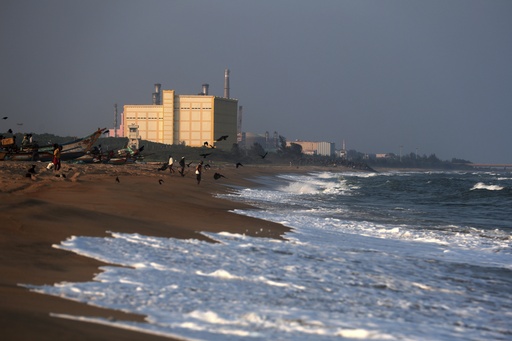
BENGALURU, India — India is aiming to increase its nuclear energy production and has announced a commitment of over $2 billion for research in this area, alongside plans to amend laws to attract more investment.
These initiatives were revealed by India’s finance minister earlier this month as part of a broader strategy to enhance electricity generation while cutting down on emissions. Nuclear energy presents an option for power generation without releasing greenhouse gases, although it does produce radioactive waste. Currently, India is one of the largest emitters of carbon emissions, with more than 75% of its electricity still generated from fossil fuels, primarily coal. The government aims to generate 100 gigawatts of nuclear power by 2047, which is projected to supply energy to nearly 60 million households annually.
Experts in energy assert that a transition away from carbon-intensive energy sources such as coal, oil, and gas necessitates reliable alternatives like nuclear power, especially since solar and wind energy cannot consistently produce electricity due to availability issues. However, some experts express doubt about India’s ambitious goals, noting that the country’s nuclear sector remains relatively underdeveloped, and public sentiments about nuclear safety are often negative.
Shayak Sengupta, a senior research associate at Columbia University’s Center on Global Energy Policy, commented that the evolving trade environment under the new U.S. administration could facilitate India’s nuclear growth ambitions. The nation’s nuclear development efforts represent significant opportunities for U.S. companies, which have a more advanced nuclear power sector and are innovating in areas such as smaller and more affordable reactors. India is also making investments in the development of these smaller nuclear reactors.
Indian Prime Minister Narendra Modi is scheduled to discuss these nuclear power plans with President Trump during their upcoming meeting, alongside other pressing issues, as noted by India’s oil minister.
However, from a cost perspective, nuclear power currently remains about three times more expensive than solar power in India, and the installation timeline for nuclear facilities can stretch up to six years, compared to less than a year for solar projects. While new small modular reactors can be economically constructed and brought online more rapidly, they produce a lower amount of electricity.
Over the past decade, India has successfully doubled its installed nuclear capacity but this still accounts for only 3% of the country’s total electricity generation. The challenge for the Indian government lies in winning public acceptance for new nuclear projects. Ruchita Shah, an energy analyst at the climate think-tank Ember, highlighted local opposition to nuclear facilities, referencing protests at the Kudankulam nuclear power plant in the south and at proposed sites in Maharashtra, which stem from safety and environmental concerns.
Nonetheless, there is a marked surge in interest towards nuclear energy among stakeholders, with Brent Wanner, head of the power sector unit at the International Energy Agency (IEA), indicating that interest is at its peak since the oil crises of the 1970s due to the reliability and environmental benefits of nuclear energy.
The IEA has reported that there are currently 63 nuclear reactors under construction worldwide — the highest number since 1990. Wanner emphasized the crucial role of government support in moving nuclear energy projects forward, labeling India’s strategy as “very positive” for the sector.
Even as India focuses on expanding its nuclear capabilities, experts like Madhura Joshi from climate think tank E3G recommend not overlooking other renewable energy sources. She pointed out that “solar, other renewables, and storage can be developed much quicker,” providing immediate solutions for the energy challenges faced today.

